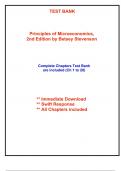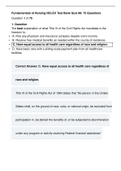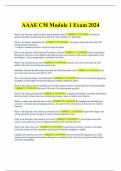TEST BANK
Principles of Microeconomics,
2nd Edition by Betsey Stevenson
Complete Chapters Test Bank
are included (Ch 1 to 20)
** Immediate Download
** Swift Response
** All Chapters included
,Table of Contents are given below
Chapter 1 The Four Core Principles of Economics
Chapter 2 Demand and Consumer Choice
Chapter 3 Supply and Producer Choice
Chapter 4 Equilibrium: Where Supply Meets Demand
Chapter 5 Elasticity: Measuring Responsiveness
Chapter 6 Taxes, Price Controls, and Quantity Regulations
Chapter 7 Welfare Economics: Evaluating Market Efficiency and Market Failure
Chapter 8 Comparative Advantage and Gains from Trade
Chapter 9 International Trade
Chapter 10 Externalities and Public Goods
Chapter 11 The Labor Market
Chapter 12 Why Wages Vary: Workers, Jobs, Institutions, and Discrimination
Chapter 13 Inequality, Poverty, and Social Insurance
Chapter 14 Market Structure and Degrees of Market Power
Chapter 15 Entry, Exit, and Long-Run Profitability
Chapter 16 Price Discrimination and Sophisticated Pricing Strategies
Chapter 17 Economics of Strategic Management
Chapter 18 Game Theory and Strategic Choices
Chapter 19 Decisions Involving Uncertainty
Chapter 20 Decisions Involving Private Information
,The test bank is organized in reverse order, with the last chapter displayed first, to ensure that
all chapters are included in this document. (Complete Chapters included Ch20-1)
Name: Class: Date:
Chap 20 2e Stevenson
Indicate the answer choice that best completes the statement or answers the question.
1. David pays $5,400 per year to an insurance company in return for its promise to pay part of his family's
medical bills. The $5,400 is David's:
a. risk.
b. marginal utility.
c. expected utility.
d. premium.
2. Your friend Donald owes you $100 but does not currently have the money to pay you back. He proposes a
double-or-nothing wager. He wants to flip a coin and, if the coin lands heads, he will pay you $200, but if the
coin lands tails, he will pay you nothing. You decline because the wager:
a. doesn't change your expected value, but it does increase your risk.
b. doesn't change your risk, but it decreases your expected value.
c. reduces your expected value and your risk.
d. does not sufficiently reduce your risk.
3. Hilary and Larissa make up the auto insurance market. Hilary has a 10% probability of having an accident
this year, whereas Larissa has a 5% probability of having an accident. What is the probability that Hilary and
Larissa will both have accidents this year?
a. 0.15%
b. 0.75%
c. 0.005%
d. 0.5%
4. Which is NOT a factor that makes insurance more worthwhile to an individual?
a. The individual is more risk averse.
b. The stakes are larger.
c. The insurance is closer to being actuarially fair.
d. The risk factor of the situation is lower.
5. People who are overconfident are likely to:
a. overestimate risks and make bad decisions.
b. underestimate risks and make bad decisions.
c. overestimate risks leading to good decisions.
d. underestimate risks leading to good decisions.
Page 1
, Name: Class: Date:
Chap 20 2e Stevenson
6. (Table: Total Utility and Choices with Uncertainty and Scenario: A Novelist or a Teacher) Use Table: Total
Utility and Choices with Uncertainty and Scenario: A Novelist or a Teacher. Given this information, Elizabeth,
as a utility maximizer:
Scenario: A Novelist or a Teacher
Elizabeth is working as a high school English teacher and is considering leaving her teaching job to ghost
write biographies for Hollywood actors. Her teaching job pays $40,000 per year. In contrast, the ghost
writing will pay $25,000 for the first year whether the biography is a success or not, $50,000 if it is a
success, and $100,000 if it is a success and is optioned for a movie deal. Elizabeth is a utility maximizer; her
utility function is shown in the table.
Total Utility and Choices with
Uncertainty
Income Total Utility
$25,000 1,500
$30,000 1,900
$35,000 2,250
$40,000 2,550
$45,000 2,800
$50,000 3,000
$55,000 3,150
$60,000 3,250
$65,000 3,300
$100,000 3,500
a. should keep her teaching job.
b. should quit her teaching job and go to Hollywood.
c. will be indifferent between leaving and staying because her expected income is the same whether she
remains a teacher or moves to Hollywood.
d. will be indifferent between leaving and staying because her expected total utility is the same whether
she remains a teacher or moves to Hollywood.
Page 2






